Recent Posts
Why Is Mold Growing in My Attic?
7/17/2024 (Permalink)
 By addressing the underlying causes of mold growth in your attic, you can protect your home from mold-related damage.
By addressing the underlying causes of mold growth in your attic, you can protect your home from mold-related damage.
Mold growth in your attic can be a concerning issue that affects both the home's indoor air quality and structural integrity. Understanding why mold grows in your attic and how to address the problem can help you protect your home. Here's what you need to know:
Causes of Mold Growth
Several factors contribute to mold growth in attics, including:
Poor Ventilation
Inadequate ventilation in the attic can lead to moisture buildup, creating the ideal environment for mold growth. Without proper airflow, condensation can accumulate on surfaces, promoting mold growth over time.
Roof Leaks
Roof leaks are a common cause of moisture intrusion in attics. Water from leaking roofs can seep into the attic space, saturating insulation and wood framing and creating conditions conducive to mold growth.
High Humidity
High humidity levels in the attic, often exacerbated by poor ventilation, can create a damp environment that encourages mold growth. Areas with limited airflow, such as corners and eaves, are particularly susceptible to mold infestation.
Insufficient Insulation
Inadequate insulation in the attic can lead to temperature differentials between the attic and the rest of the home, resulting in condensation and moisture buildup. This moisture provides a breeding ground for mold spores to thrive.
Plumbing Leaks
Plumbing leaks or pipe condensation in the attic can introduce moisture into the space, promoting mold growth on nearby surfaces.
Solutions for Mold Prevention
To prevent mold growth in your attic, consider the following solutions:
- Improve Ventilation: Ensure that your attic has adequate ventilation to promote airflow and reduce moisture buildup. Installing vents, such as soffit, ridge, or gable vents, can help facilitate proper ventilation and prevent mold growth.
- Address Roof Leaks: Regularly inspect your roof for signs of damage or leaks, such as missing shingles or damaged flashing. Promptly repair any issues to prevent water intrusion into the attic space.
- Control Humidity: Use a dehumidifier or air conditioner to control humidity levels in the attic, especially during humid weather or in poorly ventilated areas. Keeping humidity levels below 60% can help prevent mold growth.
- Proper Insulation: Ensure that your attic is properly insulated to maintain consistent temperatures and reduce condensation. Consider adding additional insulation or upgrading existing insulation to improve energy efficiency and prevent moisture buildup.
- Repair Plumbing Leaks: Regularly inspect plumbing fixtures and pipes in the attic for leaks or condensation. Promptly repair any leaks or condensation issues to prevent moisture buildup and mold growth.
By addressing the underlying causes of mold growth in your attic and implementing preventive measures, you can protect your home from mold-related damage and maintain a healthy indoor environment. Regular maintenance and proactive measures are key to preventing mold growth and preserving the integrity of your attic space.
Preventing Bacterial Growth After Water Intrusion: Essential Steps for Effective Water Remediation
6/12/2024 (Permalink)
 In this blog, we will discuss essential steps and methods to prevent bacterial growth after water intrusion.
In this blog, we will discuss essential steps and methods to prevent bacterial growth after water intrusion.
Water intrusion can cause extensive damage to our properties, but it can also create optimal conditions for bacterial growth if not addressed promptly and effectively. Preventing bacterial growth after water damage is crucial for ensuring a safe and sanitized environment. In this blog, we will discuss essential steps and methods to prevent bacterial growth after water intrusion, providing you with a comprehensive guide for effective water remediation.
Act Swiftly
Time is of the essence when it comes to preventing bacterial growth after water damage. The longer the water sits, the greater the chance of bacterial contamination. Immediately addressing the issue by contacting a professional water remediation service like SERVPRO® is crucial for preventing bacterial growth.
Identify and Eliminate the Source
Before beginning the restoration process, it is important to identify and eliminate the source of water intrusion. This can range from roof leaks to burst pipes or faulty appliances. By fixing the source of the leak, you can prevent further water intrusion and minimize the risk of bacterial growth.
Remove Standing Water
Standing water is a potential breeding ground for bacteria and other microbes. Using pumps, wet vacuums, and other water extraction equipment, remove any standing water from the affected area. This step is vital to minimize the risk of bacterial growth and prevent further damage to your property.
Thoroughly Dry Affected Areas
After removing standing water, it is crucial to thoroughly dry affected areas to prevent bacterial growth. Utilize professional-grade dehumidifiers, fans, and other drying equipment to ensure that moisture is completely eliminated. Pay special attention to hidden spaces and hard-to-reach areas, as they can retain moisture and foster bacterial growth if left untreated.
Clean and Disinfect
Cleaning and disinfecting affected areas are vital steps in preventing bacterial growth after water intrusion. Use appropriate cleaning agents to sanitize all surfaces, including walls, floors, furniture, and personal belongings. Pay extra attention to areas with visible contamination or water stains.
Inspect for Mold
Water damage can often lead to mold growth, which can exacerbate bacterial growth. After water remediation, conduct a thorough inspection for any signs of mold. If mold is present, it is essential to address the issue promptly to prevent further damage and health risks.
Monitor and Maintain Indoor Humidity Levels
Maintaining proper indoor humidity levels is another effective measure for preventing bacterial growth. Moist environments with high humidity levels provide ideal conditions for bacteria to thrive. Regularly monitor and control indoor humidity using dehumidifiers or other moisture control equipment.
Preventing bacterial growth after water intrusion is a crucial aspect of effective water remediation. By acting swiftly, eliminating the source of water intrusion, removing standing water, drying thoroughly, cleaning and disinfecting, inspecting for mold, and maintaining proper humidity levels, you can effectively prevent bacterial growth and ensure a safe and sanitized environment for your property.
Remember, in cases of water damage, it is always recommended to seek professional help. SERVPRO specializes in water remediation and has the expertise and equipment to ensure your property is thoroughly restored and protected from bacterial growth.
By following these steps and engaging the services of a reputable water remediation company, you can effectively prevent bacterial growth after water intrusion and minimize the risk of further damage to your property.
Planning for Power Outages and Safe Generator Use
5/15/2024 (Permalink)
Power outages can occur unexpectedly and disrupt daily life, but with proper planning and safe generator use, you can minimize inconvenience and ensure the safety of your home and family. Here are some essential tips to help you prepare for power outages and safely utilize generators:
Create a Power Outage Plan
Develop a comprehensive plan for how you and your family will respond to a power outage. Identify essential items such as flashlights, batteries, food, water, and medications, and keep them easily accessible. Establish communication protocols to stay in touch with family members and neighbors during an outage.
Stock Up on Emergency Supplies
Before a power outage occurs, stock up on essential emergency supplies to sustain you and your family for several days. This includes non-perishable food items, bottled water, first aid supplies, and any necessary medications. Consider investing in a portable battery-operated or hand-crank radio for access to news and updates.
Invest in a Generator
Consider investing in a portable or standby generator to provide backup power during an outage. Choose a generator that meets your power needs and is equipped with safety features such as automatic shutoff in case of fuel leaks or carbon monoxide detection. Follow manufacturer instructions for installation and operation.
Install Transfer Switches
If using a portable generator, install transfer switches to safely connect appliances and devices to the generator without risking backfeeding electricity into the utility grid. Backfeeding can pose serious safety hazards to utility workers and neighboring properties, so it's essential to use transfer switches to isolate circuits.
Position Generators Safely
Place generators outdoors in a well-ventilated area away from doors, windows, and vents to prevent carbon monoxide buildup. Never operate a generator indoors, including in garages, basements, or enclosed spaces, as this can lead to carbon monoxide poisoning. Keep generators at least 20 feet away from your home.
Use Generators Responsibly
Operate generators according to manufacturer instructions and never overload them with too many appliances or devices. Avoid refueling generators while they are running or still hot to prevent fuel spills and fires. Regularly inspect and maintain generators to ensure they are in proper working condition.
By following these tips, you can effectively plan for power outages and safely use generators to provide backup power when needed. Remember to prioritize safety at all times and seek professional assistance if you are unsure about proper generator installation or operation. With proper preparation and precautions, you can weather power outages with confidence and peace of mind.
Wildfire Awareness: Protecting Your Home
4/17/2024 (Permalink)
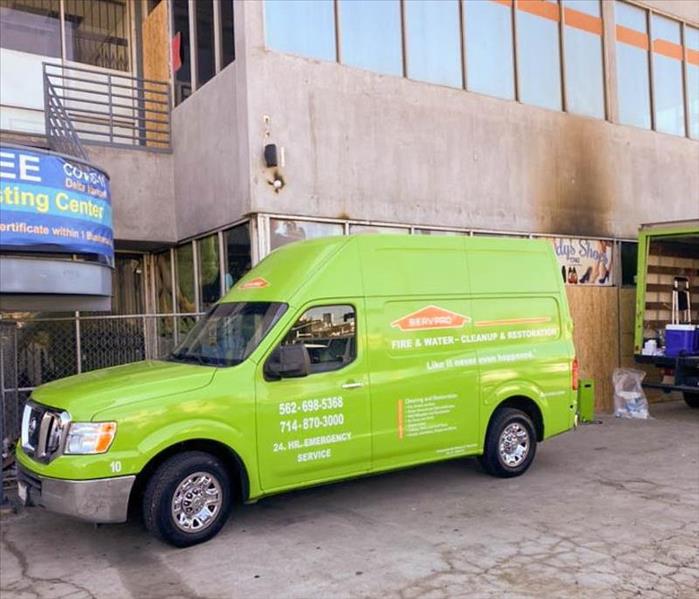 By understanding the dangers of wildfires and taking steps to prepare and protect your home, you can minimize the risk of damage.
By understanding the dangers of wildfires and taking steps to prepare and protect your home, you can minimize the risk of damage.
Wildfires are a natural phenomenon that can pose significant threats to homes and communities. In this blog, we're delving into the dangers of wildfires and sharing some practical tips on how to prepare and protect your home. By understanding the risks and taking proactive measures, you can better protect your property and loved ones from the devastating impacts of wildfires.
Understanding the Dangers
Wildfires are fast-moving, unpredictable fires that can spread rapidly, consuming everything in their path. High temperatures, dry conditions, and strong winds fuel the flames, making wildfires difficult to control and extinguish. In addition to destroying homes and natural landscapes, wildfires pose risks to humans, wildlife, and the environment.
Creating Defensible Space
Creating defensible space around your home is crucial for reducing the risk of wildfire damage. Clearing vegetation, debris, and flammable materials from the immediate vicinity of your home creates a buffer zone that can help prevent flames from reaching your property. This includes maintaining a clear zone of at least 30 feet around structures and ensuring that trees are pruned and grass is kept short.
Hardening Your Home
In addition to creating defensible space, hardening your home against wildfires is essential for improving its resilience to fire. This involves using fire-resistant building materials, such as metal roofing, non-combustible siding, and tempered glass windows. Installing ember-resistant vents and enclosing eaves and soffits can also help prevent ember intrusion, which is a common cause of home ignitions during wildfires.
Developing an Evacuation Plan
Preparing for the possibility of evacuation is an important aspect of wildfire readiness. Develop a comprehensive evacuation plan that includes multiple escape routes, designated meeting points, and communication strategies. Keep important documents, medications, and emergency supplies readily accessible, and ensure that all family members are familiar with the plan and know what to do in the event of a wildfire.
Staying Informed
Stay informed about wildfire activity in your area by monitoring local news, weather forecasts, and official communications from emergency management agencies. Sign up for emergency alerts and notifications to receive timely updates about evacuation orders, road closures, and other important information. Being informed allows you to make informed decisions and take necessary actions to protect yourself and your home during a wildfire.
Wildfires are a serious threat that requires proactive preparation and vigilance. By understanding the dangers of wildfires and taking steps to prepare and protect your home, you can minimize the risk of damage and ensure the safety of your family and property. From creating defensible space and hardening your home to developing an evacuation plan and staying informed, every action you take contributes to your wildfire readiness. Don't wait until it's too late – start preparing today to protect your home from nature's fury.
Shedding Light on Mold Growth: Does Mold Grow Faster in the Light or Dark?
3/13/2024 (Permalink)
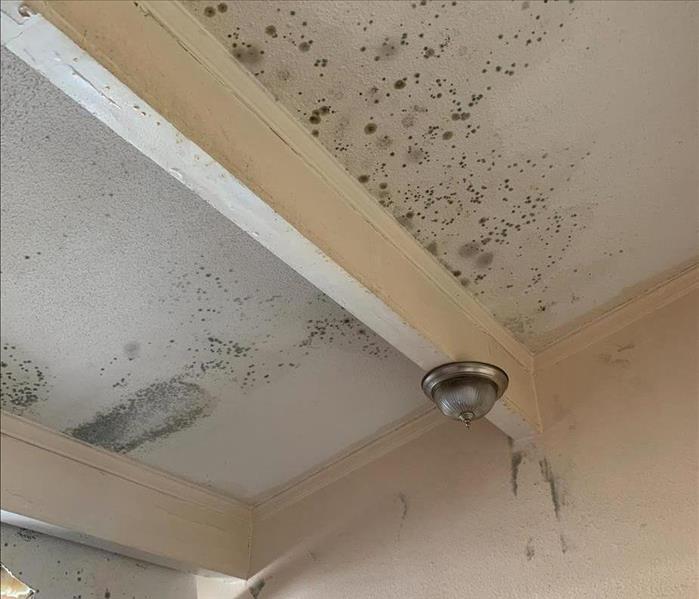 While light may reveal mold, it doesn't influence its growth rate.
While light may reveal mold, it doesn't influence its growth rate.
Picture this: you've noticed an uninvited guest making himself at home in the corners of your living space—mold. Now, you find yourself pondering a common question: does mold grow faster in the light or the dark? Let’s demystify the often misunderstood relationship between light conditions and mold growth, offering insights that go beyond the surface. So, if you've ever wondered about the impact of light on mold, you're in for a journey of clarity and understanding.
Understanding Mold's Essentials
First and foremost, mold requires three main ingredients for growth: moisture, a suitable surface, and organic matter. Light isn't on this list, but understanding how it influences mold can provide valuable insights.
Mold's Indifference to Light
Contrary to popular belief, mold doesn't have a preference for light or dark environments. Mold spores are indifferent to light conditions, and their growth primarily depends on the presence of those essential ingredients—moisture, a suitable surface, and organic matter.
The Role of Light in Mold Detection
While light itself doesn't foster mold growth, it can play a crucial role in detection. Visible mold often appears in well-lit areas because it becomes more apparent. However, this doesn't mean the light is responsible for the mold's growth—it simply exposes what's already there.
The True Culprit: Moisture
The real key to controlling mold growth is managing moisture. Mold thrives in damp conditions, and addressing the source of moisture is crucial to preventing and mitigating its development. Whether it's a leaky roof, plumbing issues, or high humidity, identifying and fixing the moisture problem is the most effective strategy.
Practical Tips for Mold Prevention
To keep mold at bay, maintain proper ventilation, address leaks promptly, and ensure proper humidity levels. Regular cleaning and maintenance can also help eliminate mold-friendly environments.
In conclusion, the light-dark debate surrounding mold growth is a common misconception. While light may reveal mold, it doesn't influence its growth rate. Understanding the basics of mold's requirements—especially its reliance on moisture—allows homeowners to create environments that are less conducive to mold growth. If you suspect you might have a mold infestation in your home or business, don’t hesitate and give our SERVPRO of Loveland team a call today!
5 Ways to Storm-Proof Your Garage Door
1/17/2024 (Permalink)
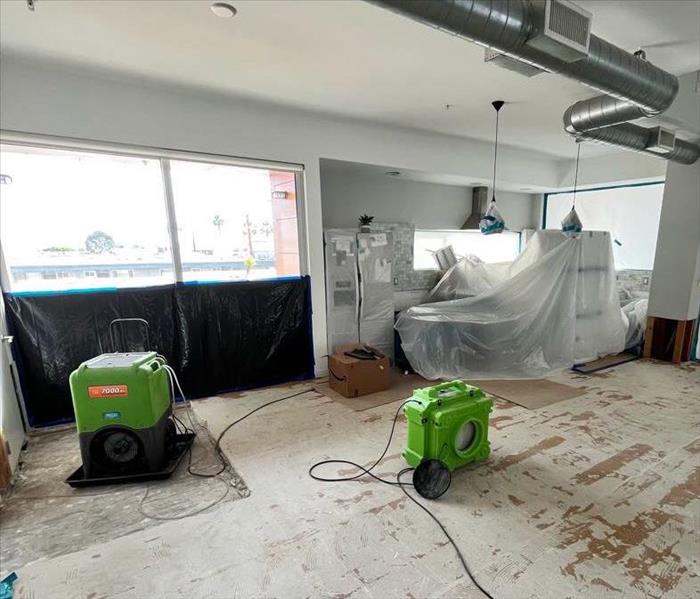 Storm-proofing your garage door is a proactive measure to protect your home and possessions during harsh weather conditions.
Storm-proofing your garage door is a proactive measure to protect your home and possessions during harsh weather conditions.
One often-overlooked area vulnerable to severe weather is the garage door. In this blog, we'll explore five practical ways to storm-proof your garage door, providing you with valuable tips to fortify your home against the elements.
Invest in a Wind-Resistant Garage Door
Upgrade your garage door to a wind-resistant model designed to withstand the force of strong winds during storms. Look for doors with reinforced panels, sturdy bracing, and a solid track system. A professional installation ensures the door is securely fitted, enhancing its ability to endure severe weather conditions.
Install Garage Door Bracing Systems
Consider installing a garage door bracing system to add extra strength and support. These systems typically involve horizontal braces across the door panels and vertical braces connecting the top of the door to the ceiling. Garage door bracing systems provide crucial reinforcement, preventing the door from bowing or collapsing under intense wind pressure.
Seal Gaps and Cracks
A well-sealed garage door is essential for keeping out wind, rain, and debris during storms. Regularly inspect your garage door for any gaps, cracks, or worn-out weatherstripping. Replace damaged weatherstripping and use caulk to seal gaps around the door frame. This not only enhances storm resistance but also improves energy efficiency.
Upgrade to Impact-Resistant Windows
If your garage door features windows, consider upgrading to impact-resistant versions. Impact-resistant windows are designed to withstand flying debris and extreme weather conditions. This adds an extra layer of protection to your garage, minimizing the risk of damage during storms.
Regular Maintenance
Consistent maintenance is key to ensuring your garage door remains storm-resistant. Check for loose hardware, tighten bolts and screws, and lubricate moving parts regularly. Address any issues promptly to keep your garage door in optimal condition and ready to face severe weather.
Storm-proofing your garage door is a proactive measure to protect your home and possessions during harsh weather conditions. Whether through wind-resistant doors, bracing systems, sealing gaps, impact-resistant windows, or regular maintenance, these strategies enhance the resilience of your garage door. Remember, if your property faces storm-related damage, SERVPRO of Loveland is here 24/7 to provide professional restoration services!
Professional vs. DIY Water Damage Cleanup - What's Best for You?
1/16/2024 (Permalink)
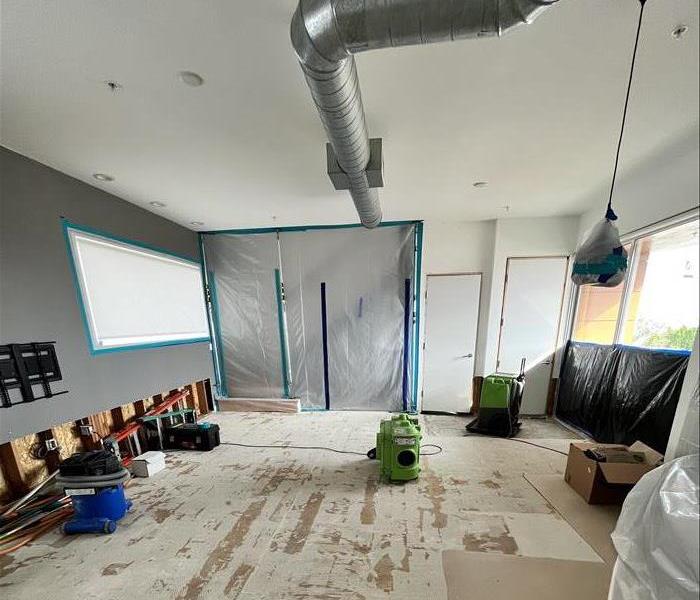 In this blog, we'll delve into the pros and cons of DIY water damage restoration versus hiring professional services.
In this blog, we'll delve into the pros and cons of DIY water damage restoration versus hiring professional services.
Water damage can strike unexpectedly, causing stress and chaos in your home or business. Whether it's from a burst pipe, a leaky roof, or a flood, the aftermath of water damage requires immediate attention. When faced with this situation, many people grapple with the decision: Should they tackle the restoration themselves or seek professional help?
In this blog, we'll delve into the pros and cons of DIY water damage restoration versus hiring professional services. Understanding the nuances can help you make an informed decision that safeguards your property and minimizes potential risks.
DIY Water Damage Restoration
The allure of handling water damage restoration on your own lies in the potential cost savings and the convenience of immediate action. DIY enthusiasts might consider extracting water, drying affected areas, and sanitizing spaces with readily available tools and techniques. However, there are crucial aspects to consider before embarking on this path:
Pros:
- Cost: DIY restoration can save money initially as you won't incur professional service fees.
- Immediate Action: You can start addressing the issue right away without waiting for service scheduling.
- Control and Involvement: You have full control over the restoration process and can ensure it meets your standards.
Cons:
- Limited Expertise: Lack of professional knowledge and equipment may result in incomplete restoration, leading to hidden moisture pockets and potential mold growth.
- Potential Risks: Mishandling electrical appliances or structural components can pose safety hazards.
- Time and Effort: The extensive process of water extraction, drying, and sanitizing can be time-consuming and physically demanding.
Professional Water Damage Restoration Services
Engaging professional water damage restoration services brings with it a level of expertise and efficiency that DIY methods may lack. Here are the key advantages and considerations:
Pros:
- Expertise and Equipment: Trained professionals possess the expertise, specialized tools, and advanced equipment to effectively handle water damage restoration.
- Comprehensive Solutions: Professionals conduct thorough assessments to identify hidden damage and provide comprehensive solutions, preventing future issues like mold growth.
- Time Efficiency: Professional services streamline the restoration process, saving time and minimizing disruption to your daily life.
Cons:
- Cost: Professional services typically come with a cost, which might be perceived as higher than the DIY approach.
- Dependency: You'll need to coordinate with the service provider's schedule, which might not offer immediate action in some cases.
Making the Right Choice
Choosing between DIY water damage restoration and professional services hinges on several factors: the extent of damage, your expertise, time constraints, and budget considerations. While DIY efforts might seem cost-effective initially, they can potentially lead to incomplete restoration and long-term issues.
On the other hand, professional services ensure a thorough, efficient restoration process, reducing risks and protecting your property effectively. Consider the trade-offs between cost, time, expertise, and the importance of comprehensive restoration before making your decision.
At SERVPRO of Loveland, we understand the stress and challenges that water damage brings. Our team of trained professionals is equipped to handle any scale of water damage restoration efficiently and effectively.
Protect your home. The Importance of Maintaining Your Dryer Vents to Prevent Fires
11/21/2023 (Permalink)
Dryer fires are a common yet preventable occurrence that can cause extensive damage to homes and put lives at risk. One crucial aspect of preventing such fires is regularly cleaning dryer vents. In this blog, we will delve into the importance of cleaning dryer vents to prevent fires and explore the steps involved in maintaining these vents.
Understanding the Risks
Dryers generate heat to dry clothes, but over time, lint and debris can accumulate in the dryer vent system. This build-up restricts airflow, causing the dryer to work harder and become hotter. The combination of excessive heat and flammable lint is a recipe for disaster, increasing the risk of a fire outbreak.
Preventing Lint Build-Up
Proper maintenance of your dryer vents includes routine cleaning to remove lint and debris. Start by cleaning the lint trap after each cycle, ensuring it's clear of any build-up. However, even with regular lint trap cleaning, lint can still accumulate in the vent system. Therefore, it's essential to schedule annual or bi-annual cleanings to thoroughly remove lint from the vent ducts.
Hiring Professional Services
While cleaning the lint trap is a task you can handle yourself, cleaning the entire vent system is best left to professionals. Certified technicians have the expertise and specialized tools to disassemble and clean the vents thoroughly. They can also identify any potential issues with the vent system, such as blockages or damage, and provide necessary repairs or replacements.
Signs of a Clogged Dryer Vent
It's crucial to be vigilant for signs that your dryer vent may be clogged, indicating the need for immediate cleaning. These signs include clothes taking longer to dry than usual, the dryer getting excessively hot during operation, a burning smell, or the presence of excessive lint or debris around the dryer vent opening. If you notice any of these signs, act promptly to prevent a potential fire hazard.
Maintenance Tips
In addition to regular vent cleaning, there are other maintenance practices to adopt to further minimize fire risks. Ensure the dryer is properly vented to the outside, avoiding long duct runs or using too many bends. Regularly inspect the vent cover outside your home and remove any obstructions, such as leaves or debris. Also, consider investing in a metal duct instead of a flexible plastic one, as it reduces the risk of lint accumulation.
By understanding the importance of cleaning dryer vents and adopting proper maintenance practices, you can significantly reduce the risk of a devastating fire. Regular cleaning, possibly with the assistance of professional services, ensures that your dryer operates efficiently, prevents overheating, and keeps your home and loved ones safe.
Remember, maintaining dryer vents is an ongoing responsibility, and prevention is key. By making it a habit to clean dryer vents regularly, you are taking a proactive step towards safeguarding your home from potential fire hazards. Don't underestimate the impact of a simple task like cleaning dryer vents – it can make a significant difference in protecting your home and promoting peace of mind.
Flood Damage vs. Water Damage: Understanding the Differences
10/24/2023 (Permalink)
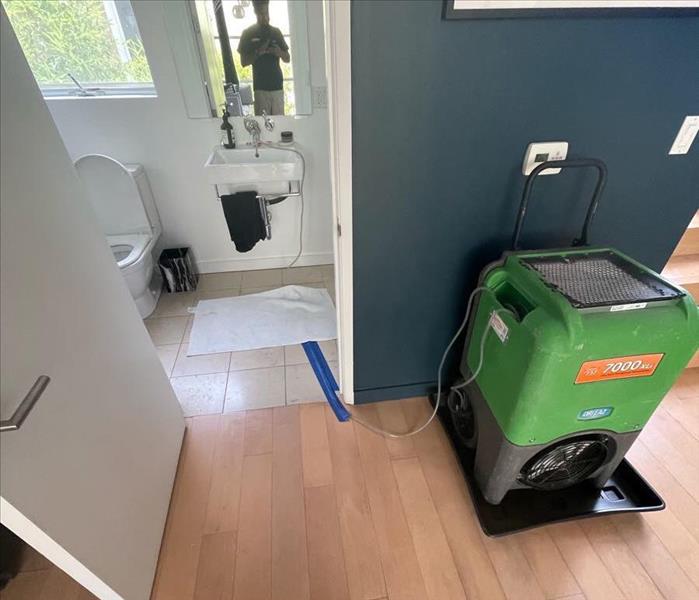 The restoration process for flood damage and water damage may also vary.
The restoration process for flood damage and water damage may also vary.
Water damage can occur in various ways, but two of the most common terms used are "flood damage" and "water damage." While they may seem interchangeable, there are key differences between the two that homeowners should be aware of. In this blog post, we will explore the distinctions between flood damage and water damage to help you understand the implications and necessary actions for each scenario.
Source of Water
The primary difference between flood damage and water damage lies in the source of the water. Water damage typically refers to damage caused by internal water sources, such as burst pipes, leaking appliances, or plumbing issues within the home. On the other hand, flood damage refers to water intrusion from external sources, such as natural disasters (heavy rain, hurricanes, river overflow) or external flooding due to issues like drainage problems or rising groundwater levels.
Scale of Damage
Flood damage is usually associated with more extensive and widespread damage compared to water damage. Floodwater can rapidly enter a property and affect multiple rooms or even entire structures. It can lead to severe structural damage, ruin personal belongings, and introduce contaminants into the home. Water damage, although it can still be significant, is typically localized to specific areas or rooms affected by the internal water source.
Contamination Levels
Floodwater is often considered more hazardous and contaminated compared to water damage caused by internal sources. Floodwater can contain various pollutants, including sewage, chemicals, debris, and bacteria, posing significant health risks. On the other hand, water damage from internal sources, while still potentially damaging, generally does not introduce the same level of contamination into the living environment.
Insurance Coverage
Insurance coverage for flood damage and water damage may differ, depending on the type of insurance policy homeowners have. Most standard homeowner's insurance policies typically cover water damage caused by internal sources, such as burst pipes. However, flood damage is not typically covered by standard homeowner's insurance and requires a separate flood insurance policy. Understanding your insurance coverage and considering additional coverage for flood damage is crucial to ensure appropriate protection in different scenarios.
Restoration Process
The restoration process for flood damage and water damage may also vary. Flood damage often requires more extensive remediation and restoration efforts due to the scale of damage and potential contamination. It may involve water extraction, disinfection, drying, mold remediation, structural repairs, and content restoration. Water damage restoration, while still requiring prompt action, may involve localized drying, repairs, and addressing any affected areas.
Distinguishing between flood damage and water damage is essential for homeowners to understand the implications, necessary actions, and insurance coverage associated with each type. While water damage is typically caused by internal sources and may be covered under standard homeowner's insurance, flood damage stems from external sources and often requires additional flood insurance. The scale of damage, contamination levels, and restoration processes also differ significantly between flood damage and water damage. By knowing these distinctions, homeowners can be better prepared to respond to different scenarios and protect their homes in the event of water-related incidents.
Protecting Your Property from Falling Trees during a Windstorm
9/27/2023 (Permalink)
Windstorms are a common occurrence during the fall and winter months. These powerful storms bring strong winds that can cause trees to fall, posing a significant risk to your property. Understanding the potential dangers and taking proactive measures to protect your property from falling trees is crucial. In this blog post, we will explore some steps you can take to safeguard your property during windstorms.
Assess Tree Health
The first step in protecting your property from falling trees is to assess the health of the trees on your property. Look for signs of tree decay, such as hollowed-out trunks or large cavities, dead branches, or excessive leaning. These signs indicate potential weakness and make the tree more susceptible to falling during a windstorm. If you notice any of these warning signs, it is important to consult with a professional arborist to determine if the tree needs to be removed or if it can be pruned to reduce the risk of falling.
Pruning your trees regularly is an essential step in minimizing the risk of falling branches during a windstorm. Proper pruning techniques involve removing dead or weak branches, thinning out dense canopies, and trimming branches away from buildings, power lines, and other structures. It is recommended to hire a certified arborist for this task, as they have the expertise to prune trees safely and effectively.
Remove Hazardous Trees
If you have trees on your property that are extensively decayed, have large cavities, or are leaning dangerously, it may be necessary to remove them entirely. Hazardous trees pose a significant risk during windstorms and can cause significant damage to your property if they fall. Consult with a professional arborist to assess the condition of hazardous trees and determine the best course of action.
For trees that are valuable to your property or heritage trees that may have structural issues, installing tree supports and bracing systems can provide additional stability and reduce the risk of falling during windstorms. A professional arborist can assess the tree's condition and recommend appropriate tree support systems to protect your property.
Secure Outdoor Items
During windstorms, even small objects can become dangerous projectiles. Secure outdoor items such as patio furniture, garden tools, and children's toys to prevent them from being carried by the wind and causing damage to your property or neighboring structures. Store lightweight items in a safe location or tie them down securely.
If you have trees located near your home or other structures, it is crucial to maintain a safe distance between them. The general guideline is to have a buffer zone of at least the height of the tree away from buildings. This allows enough space for the tree to fall without causing significant damage to your property.
Windstorms can be powerful and pose a significant risk to your property from falling trees. By assessing tree health, properly pruning trees, removing hazardous trees, installing tree supports, securing outdoor items, and maintaining a safe distance, you can minimize the potential damage caused by falling trees during windstorms. Taking proactive measures will give you peace of mind and protect your property during windstorms.
 By addressing the underlying causes of mold growth in your attic, you can protect your home from mold-related damage.
By addressing the underlying causes of mold growth in your attic, you can protect your home from mold-related damage.


 24/7 Emergency Service
24/7 Emergency Service





